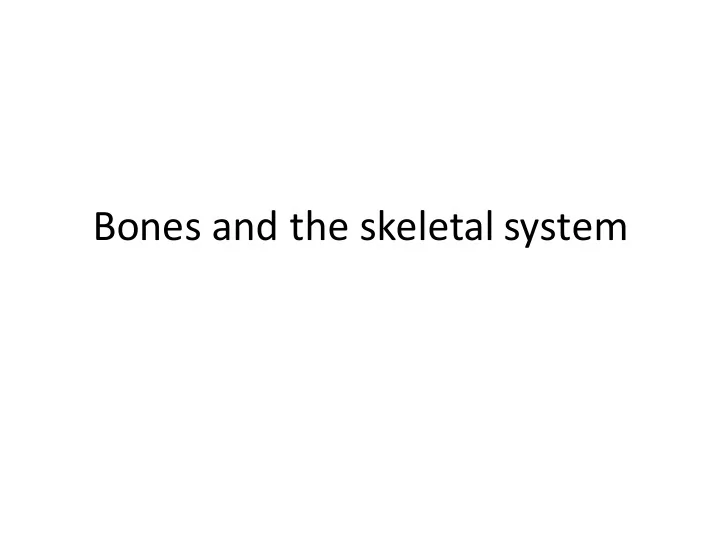

Bones and the skeletal system
I. Bone Functions A. Support B. Protection-skull, vertebral column and ribs serve to protect C. Movement-bones attach to muscles by tendons D. Mineral storage- store many types of inorganic minerals, most important are calcium and phosphate. E. Blood cell formation-called hematopoiesis and occurs inside marrow cavities.
II. Classification of Bones A. Long bones-all limb bones but patella, wrist and ankle. Mostly compact bone through diaphysis. B. Short bones-wrist and ankle bones, cube-like shape. C. Flat bones-ribs, scapula, pelvis and some bones of the skull D. Irregular bones-vertebrae, mostly spongy bone. E. Sesamoid bones (round bones)-small, round bones embedded in tendons adjacent to joints. Ex. Patella (knee cap)
Bone Shapes
III. Anatomy of Bones A. Long bones-consist of epiphysis, diaphysis, membranes such as the periosteum, osteoblasts and osteoclasts. Spongy bone and compact bone. B. All other bones-not cylindrical, contain periosteum, compact and spongy bone. C. Compact Bone-continuous extracellular matrix with no spaces made up of minerals-gives strength. The main unit is called an osteon (Haversian system). These are tiny weight bearing pillars. Blood vessels and nerves run through them. Osteocytes are bone cells found in chambers called lacunae around the osteon. D. Spongy bone-contain structures called trabeculae which are bony plates made of osteocytes interspersed by spaces filled with marrow.
ANATOMY OF A BONE
COMPACT BONE
Bone microstructure 28/08/17 8
Compact Bone
SPONGY BONE
SPONGY BONE
BONE MICROSTRUCTURE AND PROPERTIES 28/08/17 14
Mechanical Properties of Bones Cortical Bone Trabecular Bone Tensile Compressiv Shear Modulus Porosity Tensile Compressive Porosity Strength e strength strength Strength strength @ 25 ~120 MPa ~160 MPa 51.6 10 GPa ~6.5% ~12 MPa - ~50% years MPa @ 65 ~107 MPa ~135 MPa - 7 GPa ~25% ~7 MPa - ~95% years 28/08/17 15
Values of Young’s modulus of various materials 28/08/17 16
BONE REMODELING 28/08/17 17
Bone remodeling 28/08/17 18
Osteoclasts Vs. Osteoblasts 28/08/17 19
SPINE 28/08/17 20
Parts of the Spine bone 28/08/17 21
Parts of the Spine bone Anterior Anterior Posterior Posterior 28/08/17 22
Spine – medical conditions 28/08/17 23
Upright Position • Spinal Compression – Resulting From: – Body Weight + Weight Held by Arms and Hands • When Standing Upright – Total Body Center of Gravity Is Anterior to the Spinal Column. – Spine Is Placed Under Constant Forward Bending Moment. 28/08/17 24
Torque • Defined: The Rotary Effect of a Force About An Axis of Rotation, Measured as the Producer of the Force and the Perpendicular Distance Between the Force’s Line of Action And The Axis • To Maintain An Upright Position – Torque Is Counteracted by Tension in the Back Extensor Muscles. 28/08/17 25
Spinal Muscles Role In Lifting • Spinal Muscles Have Small Moment Erector Spinae Arms With Respect To the Vertebral Muscles Joints. • Have To Generate Large Forces To Counteract the Torque Produced About the Spine by Body Weight and Objects Being Lifted. 28/08/17 26
Should we lift with the leg muscles or back muscles?? • Back Muscles, With a Moment Arm of Approximately 6 cm, Must Counter The Torque Produced by the Weights of the Body Plus Any External Loads. 28/08/17 27
Question: How Much Torque Is Developed By The Erector Spinae Muscles With a Fm 6 cm? 1 lb. = 4.448 Newtons • Segment Weight Moment Arm • – Head 13 lbs. (58N) 25 cm – Trunk 73.75 lbs. (328N) 10 cm – Arms 18.2 lbs. (81N) 20 cm – Box 24.95 lbs. (111N) 40 cm Torque at L5-S1= • (328N)(10cm) + (81N)(20cm) + (58N)(25cm) + • (111N)(40cm) = ? • 10,790 Ncm • Force? • 0 = (Fm)(6cm) - 10,790 In static position, sum • of the torques acting at any point is zero. • Fm = 1798.33 N or (404.30 lbs.) • 28/08/17 28
Problem for a 135 lb. Person • How much force must be developed by the erector spinae with a moment arm of 6 cm. From the L5-S1 joint center to maintain the body in a lifting position with segment moment arms as Specified? Segment Weight Moment Arm • – Head 50 N 22 cm. – Trunk 280 N 12 cm. – Arms 65 N 25 cm. – Box Lifted 100 N 42 cm. • Torque ? • 10,285 Ncm • Fm = 1714 N or (393 lbs. Force) 28/08/17 29
What Does The Research Show? % Load Compression On L3 During the Upright Standing, Lying Down, and Sitting. • Compression Increases More with Spinal Flexion, and Increases Still Further with a • Slouched Sitting Position. 28/08/17 30
Common Injuries Of The Back – Low Back Pain – Soft Tissue Injuries – Acute Fractures – Stress Fractures – Disc Hernia ions – Whiplash Injuries 28/08/17 31
RATE OF MUSCLE OR JOINT MOVEMENT 28/08/17 32
Speed of Movement - Human 28/08/17 33
Recommend
More recommend